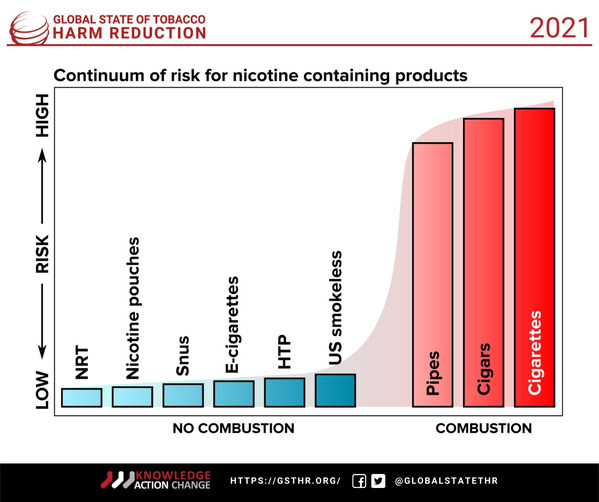LONDON, Oct. 27, 2021 /PRNewswire/ — While global leaders and media focus on UN COP26, the climate summit starting this Sunday, 182 government delegations are preparing for another COP meeting. Yet the ninth session of the COP (COP9) to the WHO Framework Convention on Tobacco Control (FCTC) from 8 – 13 November has received little attention and will be conducted in secretive closed sessions.
Fighting The Last War: The WHO and International Tobacco Control, the latest report from UK health agency KAC‘s Global State of Tobacco Harm Reduction (GSTHR) reveals that current implementation of the FCTC, which aims to reduce smoking-related death and disease, is a global public health failure. Enacted in 2005 when there were 1.1 billion smokers worldwide, today there remain 1.1 billion smokers, and eight million smoking-related deaths each year.
Harm reduction offers new hope. Vaping devices, snus, nicotine pouches and heated tobacco products are significantly safer than cigarettes, delivering nicotine without burning tobacco. This helps people who cannot or do not want to stop using nicotine to quit deadly smoking and switch.
Parties to the FCTC including the UK and New Zealand have seen marked decreases in smoking after introducing harm reduction policies alongside domestic tobacco control regimes. GSTHR estimates suggest 98 million people worldwide already use safer nicotine products. Yet report author Harry Shapiro argues that the fight against smoking is “now being actively undermined by the WHO.”
The WHO remains opposed to harm reduction for tobacco and international tobacco control is increasingly focused on banning safer products. Ideological opposition to tobacco harm reduction from influential philanthropic funders has distorted global policymaking – when harm reduction is actually named as a core element of tobacco control in the FCTC, and is key to the WHO’s drugs and HIV/AIDS programmes.
“At COP9, government delegations must prevent the slide into outright nicotine prohibition,” said Professor Gerry Stimson of KAC. “This would see a return to smoking for many people and many millions more never able to quit successfully. The age of combustion – for tobacco and for fossil fuels – has to end.”
Launched at a free online event today with international tobacco and drug policy experts and consumer advocates, the report argues that Parties to the FCTC must seize back control of FCTC COP meetings and demand evidence-based discussions on safer nicotine products and tobacco harm reduction. Funding for the GSTHR project was provided by a grant from the Foundation for a Smoke-Free World.
Infographic – https://mma.prnasia.com/media2/1668005/KAC_Infographic.jpg?p=medium600
Donate To The Indian Sun
Dear Reader,The Indian Sun is an independent organisation committed to community journalism. We have, through the years, been able to reach a wide audience especially with the growth of social media, where we also have a strong presence. With platforms such as YouTube videos, we have been able to engage in different forms of storytelling. However, the past few years, like many media organisations around the world, it has not been an easy path. We have a greater challenge. We believe community journalism is very important for a multicultural country like Australia. We’re not able to do everything, but we aim for some of the most interesting stories and journalism of quality. We call upon readers like you to support us and make any contribution. Do make a DONATION NOW so we can continue with the volume and quality journalism that we are able to practice.
Thank you for your support.
Best wishes,
Team The Indian Sun













